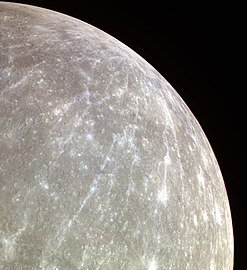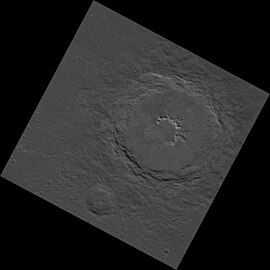 Photo of Hokusai by MESSENGER | |
| Feature type | Peak-ring impact basin |
|---|---|
| Location | Hokusai quadrangle, Mercury |
| Coordinates | 58°18′N 342°18′W / 58.3°N 342.3°W |
| Diameter | 95 km (59 mi) |
| Eponym | Katsushika Hokusai[1] |
Hokusai is a rayed impact crater on Mercury, which was discovered in 1991 by ground-based radar observations conducted at Goldstone Observatory.[2] The crater was initially known as feature B. Its appearance was so dissimilar to other impact craters that it was once thought to be a shield volcano. However, improved radar images by the Arecibo Observatory obtained later in 2000–2005 clearly showed that feature B is an impact crater with an extensive ray system. The bright appearance of rays in the radio images indicates that the crater is geologically young; fresh impact ejecta has a rough surface, which leads to strong scattering of radio waves.[2]
Hokusai is named after Katsushika Hokusai (1760–1849), a Japanese artist and printmaker of the Edo period.[3][1] The name Hokusai was suggested by radar astronomer John K. Harmon.[4] The crater has a diameter of about 100 km; the rays extend for thousands kilometers, covering much of the northern hemisphere.[5]
Hokusai is the fourth-largest crater of the Kuiperian system on Mercury. The largest is Bartók crater.[6] Hokusai is one of 110 peak ring basins on Mercury.[7]
-
The rays of Hokusai crater (near central horizon) extend across much of the planet
-
The ray system close to the crater
-
MESSENGER WAC image
-
Mosaic of MESSENGER NAC images
-
Another mosaic of the interior
- ^ a b "Ten Craters On Mercury Receive New Names". SpaceDaily. Retrieved March 29, 2010.
- ^ a b Harmon, John K.; Slade, Martin A.; Butler, Bryan J.; Head, James W.; Rice, Melissa S.; Campbell, Donald B. (2007). "Mercury: Radar images of the equatorial and midlatitude zones". Icarus. 187 (2): 374–405. Bibcode:2007Icar..187..374H. doi:10.1016/j.icarus.2006.09.026.
- ^ "Hokusai (crater)". Gazetteer of Planetary Nomenclature. USGS Astrogeology Research Program.
- ^ "Hokusai Paints a Wave of Rays". NASA/Johns Hopkins University Applied Physics Laboratory/Carnegie Institution of Washington. 11 May 2010. Archived from the original on 5 October 2013. Retrieved 13 May 2012.
- ^ "PIA11356: Looking Back to the Source". NASA. October 6, 2008. Retrieved March 29, 2010.
- ^ Denevi, B. W., Ernst, C. M., Prockter, L. M., and Robinson, M. S., 2018. The Geologic History of Mercury. In Mercury: The View After MESSENGER edited by Sean C. Solomon, Larry R. Nittler, and Brian J. Anderson. Cambridge Planetary Science. Chapter 6, Table 6.4.
- ^ Chapman, C. R., Baker, D. M. H., Barnouin, O. S., Fassett, C. I., Marchie, S., Merline, W. J., Ostrach, L. R., Prockter, L. M., and Strom, R. G., 2018. Impact Cratering of Mercury. In Mercury: The View After MESSENGER edited by Sean C. Solomon, Larry R. Nittler, and Brian J. Anderson. Cambridge Planetary Science. Chapter 9.




